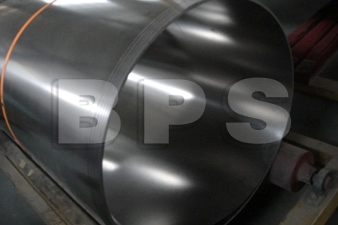 |
General description
BPA-SB-1600SM is a martensitic stainless chromium steel with an optimized analysis for high quality professional applications.
After heat treatment the composition of carbon and chromium gives a unique combination of properties including:
· Very high hardness
· Good corrosion resistance
· Very high wear resistance
Chemical composition (nominal) %
| C |
Si |
Mn |
P max |
S max |
Cr |
Mo |
| 0.6 |
0.4 |
0.4 |
0.025 |
0.010 |
13.5 |
- | Physical properties
The physical properties of a steel are related to a number of factors, including alloying elements, heat treatment and manufacturing route, but the data presented below can generally be used for rough calculations.
| Density |
 |
| g/cm3 |
7.7 |
| lb/inch3 |
0.28 | Standards: W Nr.: (1.4034/1.4037)
Forms of supply
The belt can be supplied either in coils . The coil weight is max 5 kg/mm (280 lbs/inch) of belt width.
Hardening and tempering of the steel belt is needed to achieve the correct finish and to meet the properies required by the end user.
Dimensions
| Thickness |
 |
Width |
 |
| mm (inch) |
 |
mm (inch) |
 |
| Min. |
Max |
Min. |
Max. |
| 1.0 (0.039) |
5.0 (0.197) |
10 (0.393) |
360 (15) | Tolerances.
See the tolerance tables
Mechanical properties
| As-delivered |
Tensile strength MPa (ksi) |
Hardness HV |
HRB |
| Annealed |
750 ±100 (108±14) |
240 ±40 |
98 ±14 |
| Cold rolled |
700-1000 (101-145) |
240-315 |
98-108 | Heat treatment Hardening data
Hardening temperature 1080°C (1975°F), holding time 5 minutes, quenching in oil.
Tempering data
Belt thickness 2.5 mm (0.098 inch), tempering time 30 minutes.

Brittleness occurs with tempering above 450°C (840°F).
The figures show the importance of using the right hardening conditions to optimise the micro structure of the steel.
|

|
Too high hardening temperature gives coarse structure, high austenite content (30%), few carbides. Result: Low hardeness and low wear resistance. |
|

|
Too low cooling rate after austenitising gives carbide precipitations in the grain boundaries. Result: Brittleness and reduced corrosion resistance. |
|

|
Optimised hardening conditions give optimal austenite content (15%), many uniformly distributed carbides. Result: Optimal combination of hardness, wear resistance, ductility and corrosion resistance. | How the hardening parameters affect the final hardened result:
· Too high austenitising temperature gives a high amount of retained austenite and low hardness.
· A low austenitising temperature gives a low amount of retained austenite and low hardness.
· Too long holding time at the optimal hardening temperature increases the amount of retained austenite and lower the hardness.
· The maximum hardness will be received at a retained austenite content of about 15%.
· Deep freezing i.e. cooling to below room temperature increases the hardness with about 2 HRC and improves the corrosion resistance.
· With deep freezing the highest possible hardness will be achieved by increasing the austenitic temperature above the recommended value in the hardening data.
· High cooling rate after hardening to avoid brittleness and reduced corrosion resistance. 600 degrees C (1112 degrees F) shall be reached after 1-2 minutes after hardening. |
|


